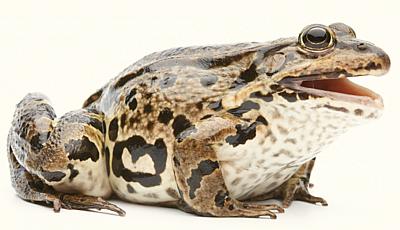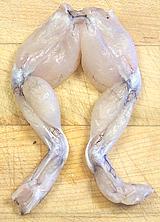 [family Ranidae (true frogs) mostly genus Rana (over 230
species)]
[family Ranidae (true frogs) mostly genus Rana (over 230
species)]
While one species of frog (Conraua goliath) can grow to 7 pounds, the edible frogs of commerce are generally less than 1 pound. While frog eating is commonly associated with France, they are much more commonly eaten in the U.S. South and Midwest, the Caribbean, Argetina, Uruguay, Africa, China and Southeast Asia. In most cases only the hind legs are eaten though in some areas for some species the back is also used.
Frozen frog legs from China and Vietnam are now common in North American markets serving local Asian communities. In Europe the most eaten frog is the Edible Frog (Rana kl. esculenta). In the North American the most eaten frog is the American Bull Frog (Rana catesbeiana), a very large frog that can grow to 1.5 pounds and is farmed in some regions. Photo © i0046.
More on Reptiles & Amphibians.
 So, does frog really taste "just like chicken"? Well, only if one of
your chicken's grandmothers was messing around with a fish - it has just
a faint suggestion of fish flavor. The flesh is mild and less stringy
than chicken, more like Alligator, actually.
So, does frog really taste "just like chicken"? Well, only if one of
your chicken's grandmothers was messing around with a fish - it has just
a faint suggestion of fish flavor. The flesh is mild and less stringy
than chicken, more like Alligator, actually.
Frog legs are generally sold by count - how many pairs makes a pound. Counts range from 2/4 for the largest and 16/20 for the smallest but 4/6 and 6/8 are the most common ranges. In some regions the legs will have the backbone and back muscles attached to the legs ("saddle on"), but those from Asia do not.
If you caught your own frogs, you'll have to cut out the legs and skin them. Frog is never cooked "skin-on" and the skin is sometimes toxic.